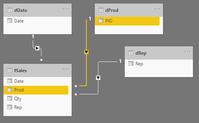Party with Power BI’s own Guy in a Cube
Power BI is turning 10! Tune in for a special live episode on July 24 with behind-the-scenes stories, product evolution highlights, and a sneak peek at what’s in store for the future.
Save the date- Power BI forums
- Get Help with Power BI
- Desktop
- Service
- Report Server
- Power Query
- Mobile Apps
- Developer
- DAX Commands and Tips
- Custom Visuals Development Discussion
- Health and Life Sciences
- Power BI Spanish forums
- Translated Spanish Desktop
- Training and Consulting
- Instructor Led Training
- Dashboard in a Day for Women, by Women
- Galleries
- Webinars and Video Gallery
- Data Stories Gallery
- Themes Gallery
- Contests Gallery
- Quick Measures Gallery
- Notebook Gallery
- Translytical Task Flow Gallery
- R Script Showcase
- Ideas
- Custom Visuals Ideas (read-only)
- Issues
- Issues
- Events
- Upcoming Events
Enhance your career with this limited time 50% discount on Fabric and Power BI exams. Ends August 31st. Request your voucher.
- Power BI forums
- Forums
- Get Help with Power BI
- DAX Commands and Tips
- Mechanism of filter propagation in default matrix ...
- Subscribe to RSS Feed
- Mark Topic as New
- Mark Topic as Read
- Float this Topic for Current User
- Bookmark
- Subscribe
- Printer Friendly Page
- Mark as New
- Bookmark
- Subscribe
- Mute
- Subscribe to RSS Feed
- Permalink
- Report Inappropriate Content
Mechanism of filter propagation in default matrix viz
Dear gurus,
As a frequent user of DAX, I understand fundamental mechanism of filter propagation, say from one side to * side along a 1:* relationship, or cross filter via bi-directional relationship, etc.
Nevertherless, I didn't wrap my head around such a seemingly-natual effect of matrix in terms of filter propagation; I can't even pinpoint keywords to google...😅 so I turn to you for help. TIA!
My mockup data model is simple enough
Then I drag columns from dimensional tables dDate[Date], dRep[Rep], dProd[PID] into rows of matrix viz, very natually, the default viz shows like this,
To my understanding, the default viz means dDate filters dRep/dProd; but theoretically, fundamental filter propagation( from 1 to * ) doesn't take effect ( maybe I'm totally wrong ) among these dimensional tables. And what's the mysterious power behind the scene?
Here's the dummy file at your disposal.
Have a nice weekend!
| Thanks to the great efforts by MS engineers to simplify syntax of DAX! Most beginners are SUCCESSFULLY MISLED to think that they could easily master DAX; but it turns out that the intricacy of the most frequently used RANKX() is still way beyond their comprehension! |
DAX is simple, but NOT EASY! |
Solved! Go to Solution.
- Mark as New
- Bookmark
- Subscribe
- Mute
- Subscribe to RSS Feed
- Permalink
- Report Inappropriate Content
Hi, @daxer-almighty , thanks for the response and by your hint, I think I found the article unveiling the mechanism under the hood, auto-exist and empty-rows removal. Here's the link to the article: https://www.sqlbi.com/articles/autoexist-and-normalization
"... two different mechanisms are working, ... auto-exist and empty-rows removal.
Auto-exists is a feature working at the server level. Auto-exists makes non-existing combinations of attributes invisible to any client tool that queries your database.
Empty-rows removal is a PivotTable feature that hides rows containing only blank values in the measures."What I tried is, according to the article, a result of empty-rows removal; whereas auto-exist is a more profound and instrinsic mechanism easily to neglect. Thus I amend another matrix in this regard in my dummy file.
| Thanks to the great efforts by MS engineers to simplify syntax of DAX! Most beginners are SUCCESSFULLY MISLED to think that they could easily master DAX; but it turns out that the intricacy of the most frequently used RANKX() is still way beyond their comprehension! |
DAX is simple, but NOT EASY! |
- Mark as New
- Bookmark
- Subscribe
- Mute
- Subscribe to RSS Feed
- Permalink
- Report Inappropriate Content
- Mark as New
- Bookmark
- Subscribe
- Mute
- Subscribe to RSS Feed
- Permalink
- Report Inappropriate Content
Hi, @daxer-almighty , thanks for the response and by your hint, I think I found the article unveiling the mechanism under the hood, auto-exist and empty-rows removal. Here's the link to the article: https://www.sqlbi.com/articles/autoexist-and-normalization
"... two different mechanisms are working, ... auto-exist and empty-rows removal.
Auto-exists is a feature working at the server level. Auto-exists makes non-existing combinations of attributes invisible to any client tool that queries your database.
Empty-rows removal is a PivotTable feature that hides rows containing only blank values in the measures."What I tried is, according to the article, a result of empty-rows removal; whereas auto-exist is a more profound and instrinsic mechanism easily to neglect. Thus I amend another matrix in this regard in my dummy file.
| Thanks to the great efforts by MS engineers to simplify syntax of DAX! Most beginners are SUCCESSFULLY MISLED to think that they could easily master DAX; but it turns out that the intricacy of the most frequently used RANKX() is still way beyond their comprehension! |
DAX is simple, but NOT EASY! |
Helpful resources

Power BI Monthly Update - July 2025
Check out the July 2025 Power BI update to learn about new features.

Join our Fabric User Panel
This is your chance to engage directly with the engineering team behind Fabric and Power BI. Share your experiences and shape the future.

| User | Count |
|---|---|
| 23 | |
| 10 | |
| 10 | |
| 9 | |
| 7 |


